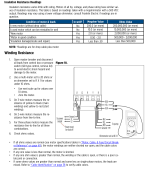fastline
Senior Member
- Location
- midwest usa
- Occupation
- Engineer
That's sort of the issue that gets me involved. ECs do their thing, plumbers the other, but you really have to work both. What I find mostly is "pump guys" that sort of understand both, but largely lacking in electrical. Check valve on top of pump end, pitless adapter, pipe issues down hole, etc. Most common is pressure tank issues that certainly cause bad pump behavior, leading to pump failure, then never properly addressed.I leave plumbing to those who know how.
My cousin is a master plumber. I call him with plumbing he calls me with electric. Easy peezy!
Kinda have to know the full system to get them fixed up right. Generally if I end up on scene, it's 'after others', so that makes it worse, but my mission is always to first make the call if the pump has to come out or not. The cause is not always as urgent as making the pump pull plan. Usually I have suspects in minutes like "pump/motor coupler is likely blown". I guess I know what I'm looking for.


